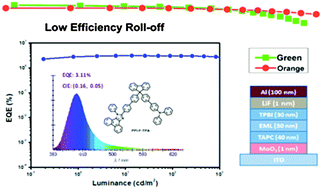A novel bipolar phenanthroimidazole derivative host material for highly efficient green and orange-red phosphorescent OLEDs with low efficiency roll-off at high brightness†
Abstract
A new bipolar fluorophore, N,N-diphenyl-4′-(9-(4′-(1-phenyl-1H-phenanthro[9,10-d]imidazol-2-yl)-[1,1′-biphenyl]-4-yl)-9H-fluoren-9-yl)-[1,1′-biphenyl]-4-amine (PPI-F-TPA), consisting of an electron-withdrawing phenanthro[9,10-d]imidazole (PI) chromophore and an electron-donating triphenylamine group, based on an indirect linkage, has been designed and synthesized. The sp3-hybridized C9 atom of the fluorene linkage efficiently interrupts molecular conjugation and inhibits π–π intermolecular interactions, resulting in efficient violet-blue emission, excellent thermal stability and high triplet energy. Equipped with balanced carrier mobility, PPI-F-TPA shows impressive performance as the emitting layer in non-doped OLEDs, which achieved an external quantum efficiency (EQE) of 3.11% with a CIE coordinate of (0.16, 0.05). Furthermore, the high triplet energy allows PPI-F-TPA to be used as a host for PhOLEDs. High performance green and orange-red PhOLEDs with the maximum EQEs, current efficiencies (CE) and power efficiencies (PE) of 15.6% and 12.5%, 57 cd A−1 and 27 cd A−1, 60 lm W−1 and 28.3 lm W−1, respectively, have been successfully obtained. More importantly, all the devices exhibit low efficiency roll-off; in particular, that of the orange-red PhOLEDs is extremely small. The orange-red PhOLED has a decay rate of EQE less than 1% at 1000 cd m−2, 13.6% at 10 000 cd m−2 and 29.5% even at 50 000 cd m−2, which is very rare among orange or orange-red PhOLEDs at such high brightness.


 Please wait while we load your content...
Please wait while we load your content...